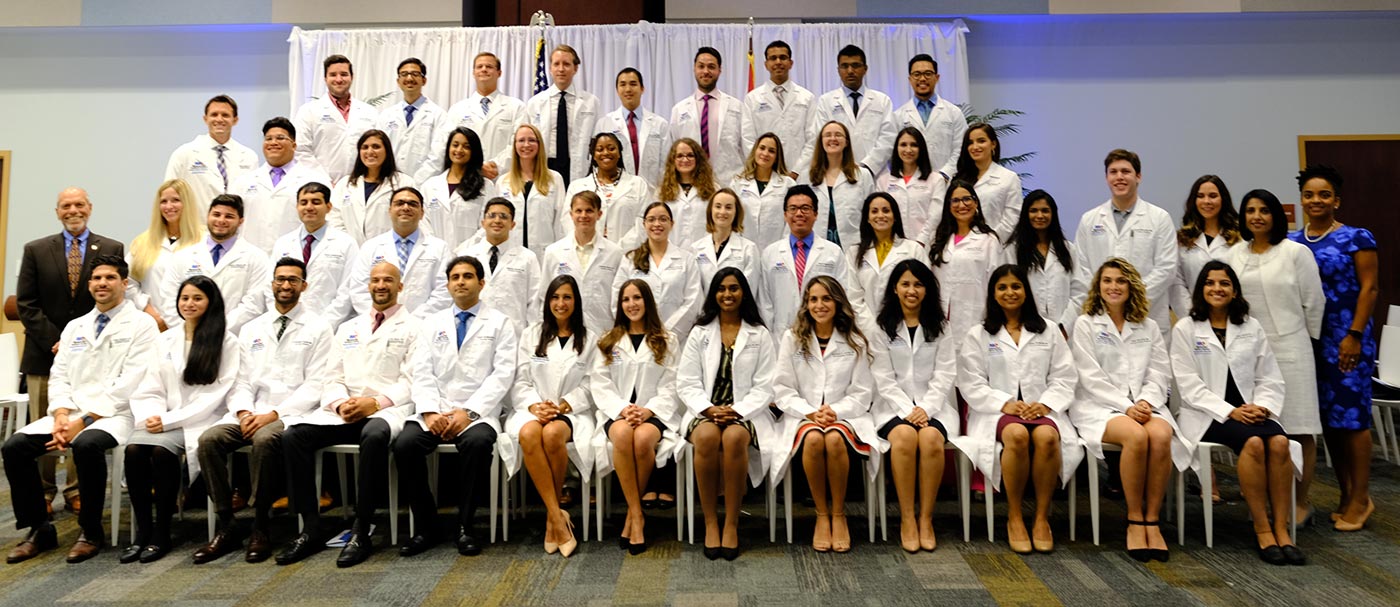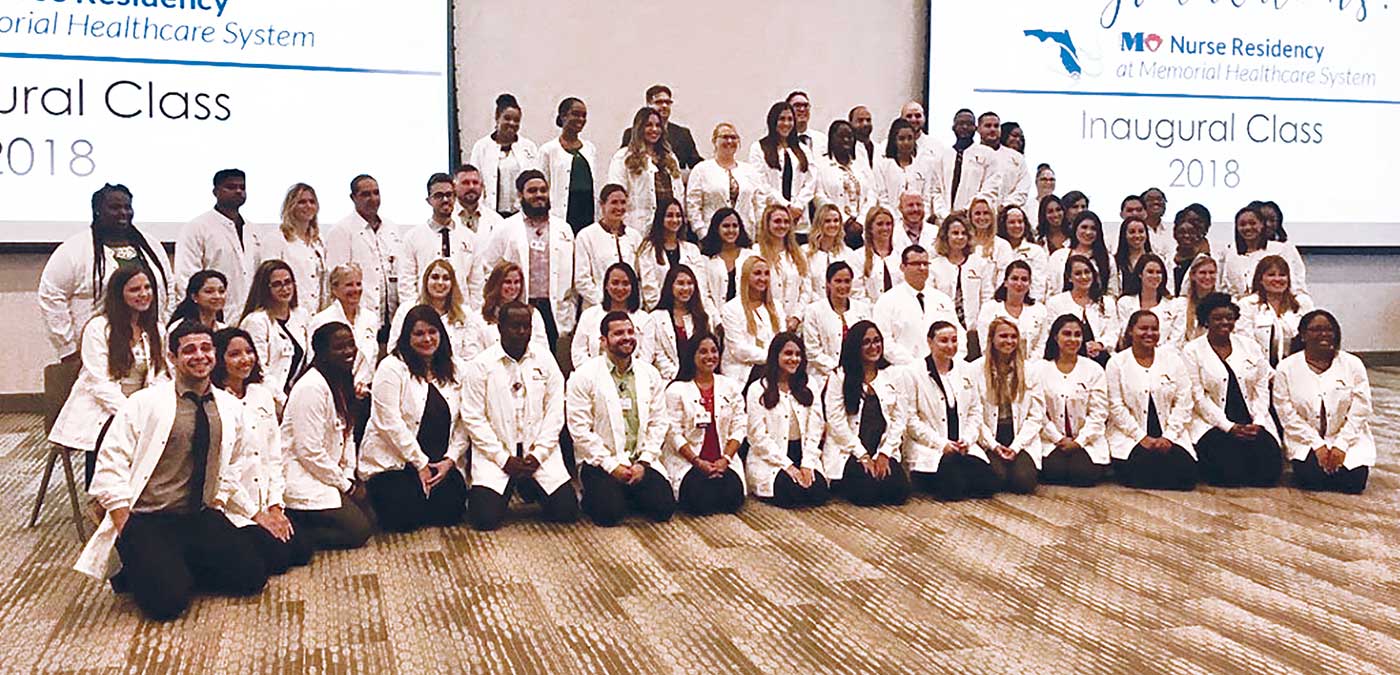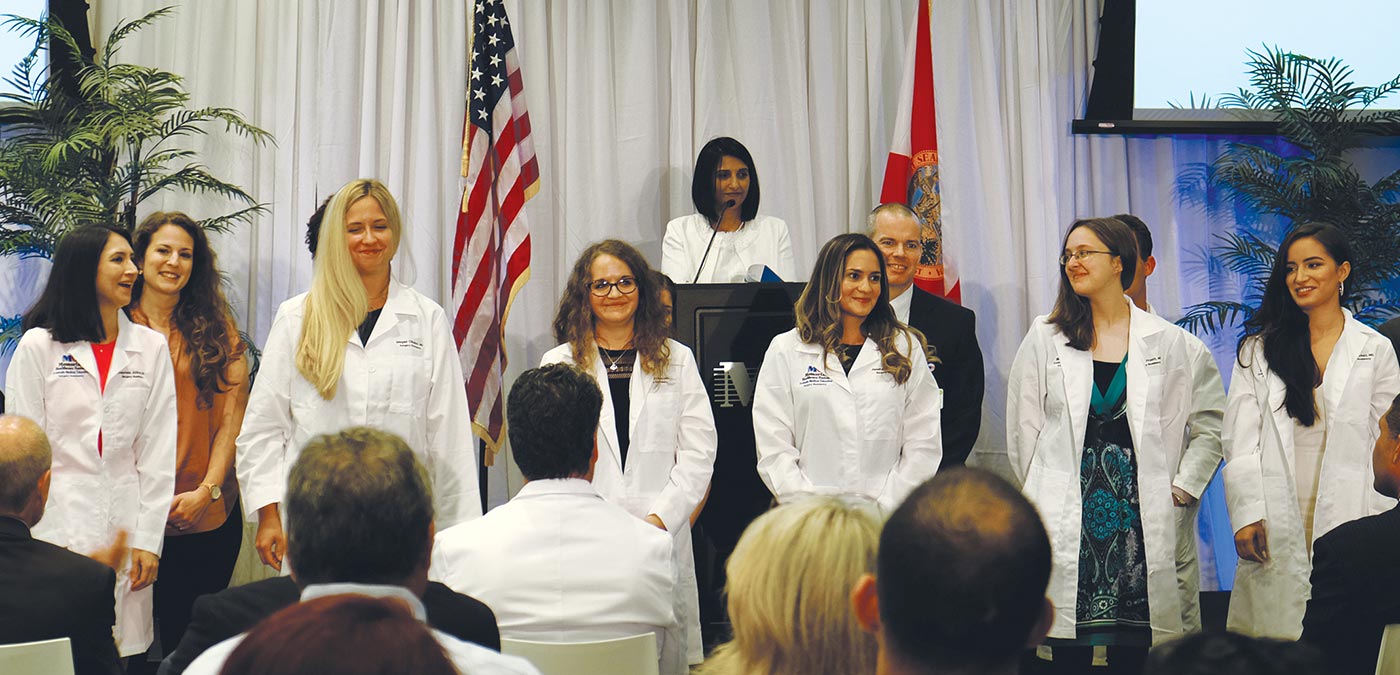
MEMORIAL ADVANCEMENTS
Graduate Medical Education Program Launches and Expands

Graduate Medical Education at Memorial Healthcare System welcomed its first class of residents in July 2018 – a successful launch of Memorial’s new program to train the physicians of tomorrow in our nationally recognized brand of patient- and family-centered care.
By the end of the fiscal year, 37 residents were actively at work, with more accredited, in seven areas: Internal Medicine, Pediatrics, Physical Medicine & Rehabilitation, Neurology, Psychiatry, Podiatry and – the program’s latest addition – General Surgery.
“We’re on track to surpass our initial five-year enrollment goals,” said Saima Chaudhry, MD, Vice President for Academic Affairs and Chief Academic Officer, Graduate Medical Education.

Memorial matches its classes of interns via the National Residency Matching Program (NRMP), and didn’t have to go far down its NRMP’s lists before all available positions in the programs were filled.
“It quickly became clear that we are highly competitive,” Dr. Chaudhry said. “Residents are attracted to Memorial because of its outstanding faculty, our diverse patient population and high-quality care. Here, they’ll see all kinds of patients representing the depth and breadth of medicine, from primary to quaternary care. By the time they come here for their interviews, they’re really sold.”
Memorial’s Graduate Medical Education program is now up to 298 approved residency positions, with more expansion planned.

“Our residents are absorbing the Memorial culture, have integrated into our teams and are working well with our supervising physicians. Our larger strategy now is to add new training programs and even greater numbers of residents. Memorial is well-positioned to become a major academic medical center.”Saima Chaudhry, MD
Vice President for Academic Affairs and Chief Academic Officer
Nurse Residency: Training the Next Generation of Nurses

Eighty-three new nurses arrived at Memorial in August 2018 to train in our new Nurse Residency Program – an evidence-based curriculum designed by the Vizient/American Association of Colleges of Nursing (AACN) to teach and develop the nurses of tomorrow.
“With so many of our seasoned baby boomer nurses retiring, we’re facing a loss of knowledge and skill,” said Maggie Hansen, RN, BSN, MHSc, Senior Vice President and Chief Nursing Executive. “Having an accredited Nurse Residency Program really helps close that gap. It allows us to transition novice nurses to competent professionals who are well-versed in Memorial’s nationally recognized culture of patient- and family-centered care.”
Under the program, new nurses are hired into a specific Memorial hospital and assigned a preceptor, who helps ensure residents follow the requirements of the curriculum, Ms. Hansen explained. The yearlong program provides hands-on clinical training, group support, and monthly seminars on “soft” skills such as communication, conflict resolution, ethics and critical thinking, among other features. In their first year, residents also develop evidence-based, applicable practice projects aimed at improving the delivery of safe, high-quality care.

“It’s very important that novice nurses have the opportunity to learn in a group cohesion model with an evidence-based curriculum so they can support each other and learn best practices,” Ms. Hansen said. “The resulting impact on engagement and retention is worth the investment in this formal residency program. It will help us meet the healthcare needs of the future by developing nurses who have the knowledge and skill necessary to provide increasingly complex care.”
Scores from nurse resident satisfaction surveys have already shown positive results: The program at Joe DiMaggio Children’s Hospital was ranked top-of-our-peer-group for overall satisfaction, second for autonomy and advocacy, fourth for overall unit engagement and fifth for overall competence.
The Nurse Residency Program launched its third cohort in March 2019 and will welcome another cohort in July and November. Ms. Hansen estimates that the program will average 80 to 90 nurses per cohort for a total of approximately 350 nurses this first year.
“One of Memorial’s Seven Pillars of Excellence is our people,” she said. “That means we have to create the kind of environment that lets our people experience the joy that nursing can bring. With the Nurse Residency Program, Memorial has made an investment in the future that’s going to be long-lasting.”
“It’s very important that novice nurses have the opportunity to learn in a group cohesion model with an evidence-based curriculum so they can support each other and learn best practices.”Maggie Hansen, MHSc, RN, BSN
Senior Vice President and Chief Nursing Executive
First General Surgery Class Is All Women

When Memorial’s General Surgery program received approval from the Accreditation Council for Graduate Medical Education (ACGME), it received hundreds of applications from interested residents across the country. The final class of six has something unique in common – they happen to all be women.
“Although women now make up 51 percent of all medical students, in surgery, men have dominated the field as working surgeons,” said Saima Chaudhry, MD, Vice President for Academic Affairs and Chief Academic Officer. “While we selected our surgical residents on the basis of merit, women applicants obviously feel comfortable coming to Memorial – and we are pleased to be ahead of that curve with our inaugural surgical class.”
Technology’s Vital Role in Outstanding Care
Advanced technology ranks high on Memorial Healthcare System’s strategic priorities – to engage patients, empower them to make sound decisions about their healthcare, and to support the overall Memorial Experience. IT can make the difference between good care and great care when its professionals feel a personal investment in patients’ and families’ well-being.
“We feel we’re healthcare people first, technologists second,” said Jeffrey Sturman, Senior Vice President and Chief Information Officer. “We view our roles as having a direct hand in patient care, even if we don’t meet patients and families face to face.”


A workplace environment that encourages employees to maximize their ability to fulfill the organization’s mission is a necessary ingredient to attracting and retaining outstanding IT team members. It’s also one of the reasons that this year, Computerworld once again named Memorial as a Best Place to Work in IT, and that Hospitals & Health Networks ranked Memorial on its list of Most Wired Hospitals & Health for the eighth time.
Overall, the focus of IT at Memorial is one of full consumerization, Mr. Sturman explained. “How do we give healthcare consumers and patients a better experience, and empower them to manage their care?” he said. “This is what we work to address every day.”
IT’s accomplishments in service of that goal were in strong evidence throughout the year. These include:
Achieving Integration – IT makes important contributions to the health of the community when it connects patients and their providers with Memorial’s technology and systems that, in turn, support the management and improvement of their health.
To that end, Memorial continued to enhance EPIC – its electronic medical records (EMR) system – adding more capabilities and extending it to non-Memorial-affiliated physicians in the community via EPIC’s Care Everywhere network. The goal: Provide patients with a more seamless medical record process – regardless of whether their doctors are employed with Memorial – and make those records available across devices, including mobile.

“Making these connections is a priority for us from a population health standpoint,” Mr. Sturman said. “It lifts the health of the community when we are proactive in using EPIC and other tools to address chronic health conditions outside our hospital system.”
Reaching HIMSS Stage 7 – Memorial received Stage 7 certification from HIMSS Analytics this year, joining an elite group of providers whose technology provides a solid foundation of support for safety, quality and patient privacy.
“HIMSS Analytics works with providers nationwide to establish benchmarks and strategies for achieving better health outcomes through IT,” said Oscar Perez, Vice President, Information Technology. “Fewer than 10 percent of hospitals nationwide have Stage 7 status, and an even smaller group of hospitals in South Florida achieve this – so it’s an excellent benchmark against which we can continually measure ourselves for improvement.”

Safety and Security – Memorial continued to devote resources to enhancing the security of its data. “It is a core interest of all healthcare providers to protect privacy, and Memorial takes that to the next level,” Mr. Sturman said. “We have the most comprehensive IT security of any healthcare system in Florida and, I would venture to say, beyond Florida. Our patients can know that when they come to Memorial, their records are secure.”
Transparency – Memorial’s online Transparency Tool, part of Memorial’s “Right To Know” initiative, received approximately 5,000 unique hits every quarter, with healthcare consumers searching among 330 planned procedures to view costs, learn financing options and choose a Memorial location. The Transparency Tool soon will add more capabilities, including online scheduling, ratings and reviews, medical staff information and video.
“We are moving forward very successfully in two complex fields – healthcare and technology,” Mr. Sturman said. “It’s rewarding when you see the fruits of your efforts combine so positively to serve patients.”

Transforming Hope Into Reality
The Office of Human Research is Memorial’s centralized office for physicians and clinical staff to perform research studies, with 34 full-time employees who work every day to transform hope into reality. Founded in 2012 by Stanley Marks, MD, FACS, Senior Vice President and Chief Medical Officer, the office now has 112 physicians actively researching across 36 subspecialties. This year, 159 open-to-accrual studies took place across the healthcare system and involved nearly 800 patients. To date, the office has conducted 760 studies touching more than 7,000 of Memorial’s patients.

Lung Cancer
Memorial Cancer Institute is a leader in immunotherapy research. The DURGA study involves a lung cancer vaccine, HSP-100. Luis E. Raez, MD, Medical Director of Memorial Cancer Institute, is the first physician in the world to use this vaccine, having completed the first human study with 19 participants in 2012. He has won several awards for the vaccine’s development, including from the American Society of Clinical Oncology.
Now, Memorial Cancer Institute is conducting studies combining the vaccine with other types of immunotherapy. “The preliminary results have been showing good benefits for patients,” said Dr. Raez, who presented at the 2018 World Conference on Lung Cancer in Toronto.
Rheumatoid Arthritis (RA)
Heather Spader, MD, and Christopher DeMassi, MD, were the first surgeons in the world to implant a new device for vagal nerve stimulation for RA. Memorial was the largest implanting site in this phase 1 trial for Setpoint Medical, which involved four patients. Preliminary data show that the minimally invasive stimulator had significant success in decreasing RA inflammation. “Memorial is positioned to play a key role in phase 2 of this pivotal study,” Dr. Spader said. Enrollment of approximately 20-30 patients will start in late 2019.
Cardiology
Memorial Cardiac and Vascular Institute is conducting multiple studies on exciting new treatments and devices. One such leading-edge trial is the Barostim neo® study. Memorial launched its trial of this pacemaker-like device – which signals the brain to reduce blood pressure and improve blood flow – in March 2018. It is currently following up with enrolled patients to determine its effectiveness.
“With heart disease continuing as the leading cause of death for both men and women, it’s gratifying for Memorial to be able to offer patients innovative cardiac therapies,” said Daniel Benhayon, MD, cardiac electrophysiologist with Memorial’s Cardiac Electrophysiology and Arrhythmia Management Program.
“This has been a huge team effort. Our researchers are key to improving the care that we offer our patients and for providing new options to patients. I’m grateful to work with this team of talented individuals who continue to expand Memorial’s academic frontier.”Candice Sareli, MD
Chief Medical Research Officer,
Memorial Office of Human Research




